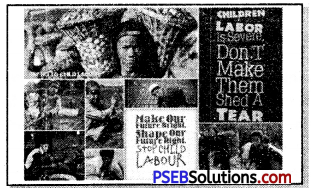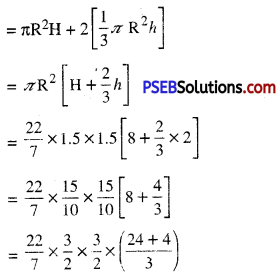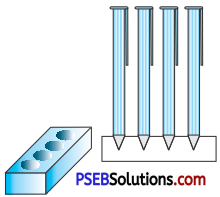Punjab State Board PSEB 7th Class English Book Solutions English Grammar Determiners Exercise Questions and Answers, Notes.
PSEB 7th Class English Grammar Determiners
Determiners वे शब्द हैं जो संज्ञा (noun) से पूर्व उसके अर्थ को किसी-न-किसी रूप में स्पष्ट करने या निश्चित करने के लिए प्रयुक्त होते हैं। यहां पर हम Determiners की एक सूची दे रहे हैं-
- Demonstratives. this, that, these, those.
- Possessives. my, your, his, her, its, our, their.
- Cardinal numbers. one, two, three, etc.
- Ordinal numbers. first, second, third, etc.
- Articles. a, an, the.
Miscellaneous. Some, any, both, certain, enough, few, every, least, less, little, more, most, much, next; other, own, plenty, several, such, many, another, each, no, a few, a large number of, a small number of, a great deal of, a good deal of, a large quantity of, a small quantity of, all, etc.

(i) Demonstratives (निर्देशक शब्द). This, that, these, those ऐसे शब्द हैं जो वस्तुओं की ओर संकेत करते हैं। अतः वे निर्देशक कहलाते हैं और इनसे Determiners की एक श्रेणी बनती है; जैसे,
- This book was purchased by me.
- That book was purchased by me.
- These girls are singing.
- Those girls are dancing.
Note. This और that एकवचन हैं जबकि these और those बहुवचन हैं।
(ii) Possessives (सम्बन्धवाचक शब्द). My, her, your, his its, our, their सम्बन्धवाचक सर्वनाम हैं और – इनका प्रयोग एकवचन और बहुवचन दोनों प्रकार की संज्ञाओं के साथ किया जाता है; जैसे
1. (a) I like my book. (Singular)
(b) I kept my books in order. (Plural)
2. (a) He told his story in tears. (Singular)
(b) People tell his stories in tears. (Plural)
3. (a) Let me see your note-book. (Singular)
(b) Teacher will check your note-books. (Plural)
Note. सम्बन्धवाचक शब्द अगणनीय संज्ञाओं से पूर्व भी प्रयुक्त किए जा सकते हैं; जैसे,
- I took my bath. (uncountable)
- His courage failed him. (uncountable)
- We cannot doubt their patriotism: (uncountable)
(iii) and (iv) Cardinal and Ordinal Numbers. Cardinal and Ordinal संख्याएं भी Determiners का एक भाग हैं।
- Two miles are left to be covered.
- I am reading the third chapter now.
- I need fifty rupees for this.
(v) The Articles. a, an तथा the को अंग्रेजी व्याकरण में articles के नाम से पुकारा जाता है। ये वास्तव में Adjective determiners हैं।
A तथा An का प्रयोग
1. सभी एकवचन Countable Nouns से पूर्व a या an का प्रयोग होता है। यदि शब्द के पहले letter की आवाज़ स्वर (Vowel) से मेल खाये तो an और यदि व्यंजन (Consonant) से मेल खाये तो a का प्रयोग होता है; जैसे,
- I saw a man.
- He saw an elephant.
- A bench is lying there.
- An ox was eating grass.
- There is a lion in the forest.
- He needs an inkpot now.
2. कुछ शब्द vowel से आरम्भ होते हैं, परन्तु उनकी आवाज़ व्यंजन (Consonants) की होती है। ऐसे एकवचन Countable nouns से पूर्व a लगता है; जैसे,-
- He is a European.
- He is a one-eyed person.
- She is a university student.
3. कुछ शब्द आरम्भ तो h से होते हैं, परन्तु यदि h मौन होने के कारण उनकी आवाज़ स्वर (Vowel) से मेल खाती है तो ऐसे h वाले एकवचन (Countable nouns) शब्दों से पूर्व an का प्रयोग होता है; जैसे,
- He reached an hour earlier.
- He is an honest man.
यदि एकवचन संज्ञा (Countable Noun) से पूर्व कोई adjective आ जाये तो a तथा an उस Adjective से पहले स्वर या व्यंजन की ध्वनि के आधार पर लगाया जाता है; जैसे,
- He is an honourable man.
- It is a useful medicine.
- The doctor gave Pratap a glass eye.
Note. 1. a या an का प्रयोग किसी वाक्य या paragraph में किसी शब्द के साथ एक बार ही होता है। दूसरी बार उसके साथ the का प्रयोग करना चाहिए; जैसे,-
I saw a lion in a forest. The forest was thick. The lion was unable to find his way through the forest.
2. Uncountable Nouns (milk, water, rice, paper) से पूर्व a या an का प्रयोग नहीं होता।
The का प्रयोग
The का प्रयोग निम्नलिखित शब्दों के साथ किया जाता है-
1. विशेष वस्तु के साथ; जैसे,
I have spent the money that my father sent me.
This is the house where my childhood passed.
2. किसी एकवचन Noun से पूर्व जब Noun किसी जाति की जानकारी के लिए प्रयोग किया जाता हो; जैसे,-
The cow is a gentle animal.
The dog is a faithful animal.
3. किसी Adverb से पूर्व जब उसका प्रयोग यूं किया जाए; जैसे,-
The higher we go the cooler it is. The more the merrier.
4. नदियों, पर्वत श्रृंखलाओं तथा द्वीप-समूहों से पूर्व; जैसे,
The Ganga, The Himalayas, The British Isles.
5. महासागरों, समुद्रों तथा खाड़ियों से पूर्व; जैसे,
The Indian Ocean, The Red Sea, The Bay of Bengal, The Persian Gulf.
6. कुछ प्रान्तों तथा देशों के नाम से पूर्व; जैसे,
The Punjab (The land of five rivers), The United States.
7. कुछ प्रसिद्ध ग्रन्थों के नाम से पूर्व; जैसे,
The Ramayana, The Mahabharata, The Vedas, The Bible.
8. Adjective की Superlative degree से पहले; जैसे,
He is the best boy of our class.
9. ऐसे Proper Noun से पहले जिसके लिए किसी विशेषण का प्रयोग हो। यदि कोई Phrase या Clause भी विशेषण के रूप में प्रयोग की गई हो तो भी The का प्रयोग किया जाता है; जैसे,
The Great Nehru, The Famous Napoleon, The Immortal Mahatma Gandhi.

10. Adjectives से पूर्व भी ‘The’ का प्रयोग किया जाता है; जैसे,
The rich should help the poor.
11. समाचार-पत्रों, पत्रिकाओं, ऐतिहासिक भवनों और कुछ विशेष संस्थाओं के नामों से पहले; जैसे,
The Tribune, The Illustrated Weekly, The Taj, The Sharma Dramatic Club.
12. जातियों तथा दशाओं से पूर्व; जैसे,
The Hindus, The east, The west.
13. कुछ ऐसे Proper Nouns के साथ जो Common Nouns के रूप में प्रयोग किये जाते हैं; जैसे,
He is the Manoj Kumar of our class.
14. कुछ Abstract Nouns से पूर्व; जैसे,
The bravery of the Rajputs is known all over the world.
Filling the Blanks with Blanks
1. Ram is ………. honest man. (an)
2. ………. book you gave me is lost. (The)
3. ………. cow is a useful animal. (The)
4. ………. Himalayas have many ranges. (The)
5. Gardening is ………. useful hobby. (a)
6. I have been waiting for you for ………. hour. (an)
7. I saw ………. Sri Harmandar Sahib. (the)
8. Who is ………. head of your family ? (the)
9. He is ………. boy who stole my pen. (the)
10. Our Principal is ………. intelligent man. (an)
11. ………. stitch in time saves nine. (A)
12. Do not make ………. noise (a)
13. My brother is ………. M.A., you are ………. B.A. (an, a)
14. New Delhi is ………. capital of India. (the)
15. This is …….. interesting story. (an)
16. He has ……… lot of money. (a)
17. He has ………. monthly income of Rs. 7000. (a)
18. ………. stars are a beautiful sight. (The)
19. Give me ………. apple or ……… orange. (an, an)
20. You should always show sympathy to ……… poor. (the)
21. Get me ………. nice cup of tea. (a)
22. This is ………. excellent watch. (an)
23. ………. rose smells sweet. (The)
24. Where is ……… book which I gave you ? (the)
25. He is ………. able student but not ……… ablest. (an, the)
26. Why are you in ………. hurry ? (a)
27. I hate ……… dishonest servant. (a)
28. He is ………. idiot. (an)
29. ………. rich are not always happy. (The)
30. ………. moon has risen. (The)
31. There was ………. army of monkeys near ………. temple. (an, the)
32. This is quite ………. new idea. (a)
33. He is ……… hardworking boy. (a)
34. I need ……… pen and ………. inkpot. (a, an)
35. I read ………. Hindustan Times everyday. (the)
36. I have not seen ………. Taj as yet. (the)
37. ………. bad workman quarrels with his tools. (A)
38. ………. apple ………. day keeps ………. doctor away. (An, a, the)
39. ………. Ganga is ………. sacred river. (The, a)
Exercises for Practice
I. 1. You are ……… intelligent student.
2. Is not he ……… school teacher ?
3. I drank all ………. milk.
4. Who invented ………. radio ?
5. There was once ……… king called Ashoka.
6. I saw ……… accident on my way to school.
7. Do you ever read …….. Gita ?
8. He is ………. best boy in the class.
9. He is ………. Napoleon of India.
10. I had ………. busy time in Mumbai.
II. 1. Believe in God and do ………. right.
2. He is ……………. S.D.O.
3. ……… stitch in time saves nine.
4. Is not he ……….. foolish person ?
5. Do not laugh at ……….. poor.
6. Child is ……….. father of man.
7. ………. apple …………day keeps………. doctor away.
8. Marconi invented ……….. machine called radio.
9. Kapil Dev is ………. cricketer.
10. ……….. rose is beautiful.
III. 1. He is ……….. fair-weather friend.
2. Both ………. teams were equally strong.
3. Kalidas is ……….. Shakespeare of India.
4. Rabindranath wrote ………. national anthem.
5. ……….. hen lays eggs.
6. ……….. sun rises in ………. east.
7. I saw ……… one-eyed man.
8. ……….. Bible is ……….. sacred book of ………….. Christians.
9. ……….. Hindus and the Sikhs should live together.
10. Lord Rama was ……….. eldest son of Dashratha.
IV. 1. He is ……… best boy in the class.
2. ……….. Ganges is ………. sacred river of ……….. Hindus.
3. ……….. Himalayas are ……….. highest mountains in ………..world.
4. Mahatma Gandhi is………father of………..nation.
5. ………dog is……..faithful animal.
6. Your brother is ……….. honest man.
7. …………. rich should help ………. poor.
8. I want ……….. orange and not ………. apple.
9. She stood first in ……….. examination.
10. My school is at ……….. stone’s throw from my house.
V. 1. He held him by ………. ear.
2. She is ………. actress.
3. He is ……….. film actor.
4. What ……….. fool he is !
5. This is ……….. old temple of Amritsar.
6. This city is situated on ……… bank of ……….. Yamuna.
7. I met ……. old man yesterday.
8. Delhi is ……….. capital of India.
9. Gurdaspur is ………. district in the Punjab.
10. Giani Zail Singh was ……….. President of India.
Miscellaneous
1. Some, any
(i) दोनों मात्रा और संख्या का ज्ञान कराते हैं। some का प्रयोग positive (सकारात्मक) तथा any का प्रयोग Negative (नकारात्मक) वाक्यों में होता है; जैसे,
I have some money.
They have some books.
He did not lend me any book.
They did not buy any book.
(ii) प्रश्नवाचक वाक्यों में some और any दोनों ही प्रयोग हो सकते हैं; जैसे,
Will you give me any money ?
Will you give me some money ?
2. Much, many
much मात्रा तथा many संख्या के लिए प्रयोग किया जाता है; जैसे,
I have many books.
I have much money.
3. Each, everyone
Each दो या अधिक व्यक्तियों या चीजों के लिए प्रयोग होता है; परन्तु वर्णित व्यक्तियों या चीजों की संख्या निश्चित होती है; जैसे,
Each player was given a prize.
There were two books in the picture. Each book had a red cover.
Every का प्रयोग दो से अधिक व्यक्तियों या चीज़ों के लिए उस समय किया जाता है जबकि व्यक्तियों या चीजों की संख्या निश्चित नहीं होती है; जैसे,
Every man and every boy should do his duty.
4. Little, a little, the little
(i) Little का अर्थ है ‘न’ के बराबर; जैसे,
Mohan is a fool and has little sense.
(ii) A little का अर्थ है ‘कुछ’; जैसे,
I am in need of a little water.
(iii) The little का अर्थ है ‘अधिक तो नहीं, परन्तु वह (थोड़ा) सारे का सारा’, जैसे,
I have spent the little money that I had.
5. Few, a few, the few.
(i) Few का अर्थ ‘कोई नहीं’ अथवा कठिनता से कोई; जैसे,
Few persons can keep a secret.
(ii) A few का अर्थ है ‘बहुत थोड़े’; जैसे,
A few persons were present at the magic show.
(iii) The few का अर्थ है ‘बहुत तो नहीं, परन्तु वे (कुछ) सभी’, जैसे,
I bought the few books that I needed.
Use of Some Other Determiners
1. He has enough money in the bank.
2. Every man wishes to be happy.
3. I have never seen such persons.
4. I want to help that man.
5. He met several people on the way.
6. He lives in his own house.
7. Those girls were absent from the class.
8. Ram has less money than I have.
9. She lives next door to me.
10. Don’t show it to other people.
11. There are certain people who can work day and night.
12. Both men were sent to prison.
13. They have plenty of money.
14. A lot of people came to see the match.
15. Most of the boys were absent yesterday.
16. You can select either book.
17. What is the latest news of the war ?
18. Mumbai is farther than Delhi.
19. I have no further information.
20. This is the last lesson of the book.

Exercises
I. Fill up the blanks with the Articles (a, an, the):
1. He can read ………. Vedas.
2. She is ………. intelligent girl.
3. ………. sun shines brightly.
4. Life is not ………. bed of roses.
5. …….. higher you climb …….. colder it gets.
6. In ………. park I saw ……… one-eyed beggar.
7. Mumbai is ………. Manchester of India.
8. ………. Sikhs are a brave nation.
9. ……… Owl cannot see during day time.
10. He became ……… doctor.
11. Mangoes are sold by ………. kilo.
12. Everest is ………. highest mountain in ………. world.
13. I caught him by ………. ear.
14. Do not make ………. noise.
15. The more, ………. merrier.
16. He is ………. one-eyed person.
17. …….. Ganges is ……… sacred river.
18. We started late in ………. afternoon.
19. ………. rose smells sweet.
20. He reads ………… Bible everyday.
21. Kalidas was ………… Shakespeare of India.
22. Einstein was ………. Newton.
23. …….. camel is ………… ship of ………. desert.
24. Can ………. leopard change its spots ?
25. ………. lotus is a lovely flower.
26. ……… rich must help ……….. poor.
27. ……… more you speak, ……….. less I understand.
28. Tagore was ………… truly great poet.
29. ………. more they get, ……… more they want.
30. This is ………. historic occasion.
31. ……………… black and white cow is grazing in the field.
32. He is ………… real Mahatma.
33. I read ………… Tribune daily.
34. I am in ………… hurry.
35. Help ………. poor.
36. Both ………. robbers were arrested.
37. Keep to ………. left.
38. ……… housemaid pulls up ………. blind.
39. What ………. lovely girl !
40. What ………. ripe apple !
41. Not ………. word was said.
42. Help ……… poor, ………. needy and ………. miserable.
43. Who is ………. cleverer of ………. two cheats ?
44. He is ………. better mechanic than clerk.
45. Read ………. third and ……. fourth chapters.
Hints:
1. the
2. an
3. The
4. a
5. The, the
6. the, a
7. the
8. The
9. An
10. a
11. the
12. the, the
13. the
14. a
15. the
16. a
17. The, a
18. the
19. The
20. the
21. the
22 the
23. The, the, the
24. a
25. The
26. The, the
27. The, the
28. a
29. The, the
30. a
31. A
32. a
33. the
34. a.
35. the
36. the
37. the
38. The, the
39. a
40. a
41. a
42. the, the, the
43. the, the
44. a
45. the, the.
II. Correct the following sentences:
1. Only few men are honest.
2. The man is mortal.
3. He acted like man.
4. Beas flows in Punjab.
5. You are in wrong but he is in right.
6. He is by far ablest boy.
7. Nobody likes a person with bad temper.
8. The iron is useful metal.
9. Not word was said.
10. He has too high a opinion of you.
11. Learn this poem by the heart.
12. Never tell lie.
Answer:
1. Only a few men are honest.
2. Man is mortal.
3. He acted like a man.
4. The Beas flows in the Punjab.
5. You are in the wrong but he is in the right.
6. He is by far the ablest boy.
7. Nobody likes a person with a bad temper.
8. Iron is a useful metal.
9. Not a word was said.
10. He has too high an opinion of you.
11. Learn this poem by heart.
12. Never tell a lie.

III. Fill in the blanks with suitable determiners:
1. I went to ………. window which commanded a large green garden.
2. I have heard so ………. about your school.
3. Look out of the window for ……… minute.
4. It is really something of ……… joke.
5. There you have …….. essential part of our system.
6. I asked her by way of ………. opening.
7. But I had ……. idea of all this.
8. Come down into …….. garden.
9. Having ………. arm tied up is troublesome.
10. It educates both ……… blind and the helpers.
Hints:
1. the
2. much
3. a
4. a
5. an
6. an
7. an
8. the
9. an
10. the.
IV. Fill in the blanks with suitable determiners:
1. We should look into ………. depth of the problem.
2. It was ………. daring idea.
3. He took the saliva from the jaws of ………. mad bulldog.
4. This is ………. good home for him.
5. ………. people had been bitten by the mad wolf.
6. He held one finger over ………. top of the tube.
7. Besides them stood Pasteur, holding a narrow tube in …….. hand.
8. They took samples from ………. brain of a dog that had died.
9. ………. little knowledge is ………. dangerous thing.
10. Your old place in ………. laboratory is waiting for you.
Hints:
1. the
2. a
3. a
4. a
5. Some
6. the
7. his
8. the
9. A, a
10. the.
V. Fill in the blanks with suitable determiners:
1. He turned to look at ………. parents.
2. ……… old banyan tree outstretched its powerful arms over other trees.
3. I want ……… pen.
4. His parents would refuse to buy him ………. flowers.
5. He was carried away by……….. rainbow glory of their colours.
6. At ………. distance, he could see men and women talking.
7. I saw ………. curious look in ………. eyes.
8. I want ………. garland.
9. I borrowed ……… books from him.
10. Is there ………. milk in the pot ?
Hints:
1. his
2. An
3. a
4. any
5. the
6. a
7. a, his
8. a
9. these
10. any.
VI. (a) Insert the determiners ‘this, that, these, those in the blanks:
1. ………. shirt is costly but …….. shirt is cheap.
2. Would you like to take ………. book or ………. one ?
3. ………. sum cannot be solved by ……. silly boys.
4. ………. flowers are beautiful but ………. flowers are ordinary ones.
5. He likes this pair of trousers but he does not like ………. One.
Hints:
1. This, that
2. this, that
3. This, those
4. These, those
5. that.
(b) Insert ‘a few’ or ‘the few’ whichever is suitable:
1. ………. books she had were all lost.
2. It is a question of spending ………. rupees.
3. ………. suggestions she gave were all carried out.
4. ……… hints on essay-writing are quite to the point.
5. …….. boys attended the class.
Hints:
1. The few
2. a few
3. The few
4. A few
5. A few
(c) Insert ‘little’, ‘a little’, or ‘the little whichever is suitable:
1. ……… knowledge is a dangerous thing.
2. There is ………. hope of his recovery.
3. He has ………. money with him.
4. ………. strength he had in him proved useless.
5. He takes ……… interest in me.
Hints:
1. A little
2. little
3. a little
4. The little
5. little.
(d) Fill in the blanks with determiners ‘each, every, either or neither:
1. ……… pen costs ten rupees.
2. He comes here on ………. Sunday.
3. ………. of you may take this book.
4. ………. man wants to rise in the world.
5. ……… seat in the hall was occupied.
Hints:
1. Each
2. every
3. Either
4. Every
5. Every.

(e) Fill in the blanks with determiners ‘much, many, some, any’:
1. Will you please give me ………. Water ?
2. There is ………. sugar in the pot.
3. Is there ………. elderly person in the house ?
4. He did not make ………. mistakes in the essay.
5. She hasn’t ……… money.
Hints:
1. some
2. much
3, any
4. any
5. any.
(f) Fill in the blanks with ‘farther, further, latter, latest, last’:
1. What is the ………. information?
2. The man in the ………. row was my uncle.
3. The old man could not go ………. without a rest.
4. The college will be closed until ………. notice.
5. Of the two, the majority accepted the ………. proposal.
Hints:
1. latest
2. last
3. farther
4. further
5. latter.
Exercises For Practice
Fill in the blanks with determiners:
1. (i) He is ………. One-eyed man.
(ii) ……….. higher you go, ……….. cooler it is.
2. (i) I want ……….. more sugar in the tea.
(ii) This is ……… boy who stood first in the class.
3. (i) How ……….. feet make one yard ?
(ii) A ……….. knowledge is a dangerous thing.
4. (i) There is ……….. slip between ………….. cup and……..lip.
(ii) How ……….. milk do you buy daily ?
5. (i) He is every inch ……….. honest man.
(ii) ……….. umbrella you brought was ……… imported one.
6. (i) Is this ……….. dog which had bitten you ?
(ii) This book contains ……….. pictures.
7. (i) There is ……….. salt, but there is not ………. chillies.
(ii) How ……….. water is there in the jug?
8. (i) He was late for school by ……… hour and …….. half.
(ii) He is ……… university professor.
9. (i) ……….. trees fell down during cyclone.
(ii) One goes to ……….. theatre to have entertainment.
10. (i) ……….. boy you met just now is my cousin.
(ii) How ………. sugar do you consume in a month ?
11. (i) ………. book was purchased by me.
(ii) Does he need ……….. kind of assistance ?
12. (i) He did not make ……….. provi’ ion for his future.
(ii) How ……….. boys failed in th: examination ?
13. (i) This is ……….. last time that i have taken meat.
(ii) Do you have ……….. book to spare ?
14. (i) Would you lend me ………. money ?
(ii) He spent ……….. little money he had.
15. (i) How ………. boys are there in the class ?
(ii) How ………. milk is there in the pot ?
16. (i) I saw …………. Sri Harmandar Sahib
(ii) Sohan is ……………… honest man.
17. (i) Do not make …………… noise.
(ii) New Delhi is ……………… capital of India.
18. (i) ……………… rich are not always happy.
(ii) He is ………….. idiot.
19. (i) Do not make ……….. noise.
(ii) She is ………… intelligent girl.
20. (i) He can read …………. Vedas.
(ii) It was ………… daring idea.
21. (i) I am in ……………. hurry.
(ii) ……………… rose smells sweet.
22. (i) Look out of the window for ………. minute.
(ii) Your old place in ………………. laboratory is waiting for you.
23. (i) I have heard so ……………… about your school.
(ii) He takes …………….. interest in me.
24. (i) Is there …………… milk in the pot ?
(ii) ……………… seat in the hall was occupied.

25. (i) She is ………….. intelligent girl.
(ii) Do not make …………. noise.
26. (i) He is ………… one-eyed man.
(ii) He lost ……….. books he had.

![]()

![]()


![]()

![]()


![]()

![]()

![]()
![]()







































